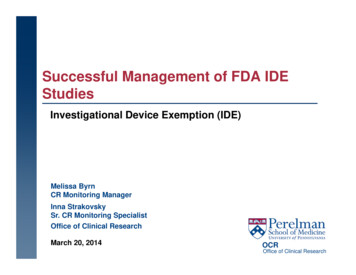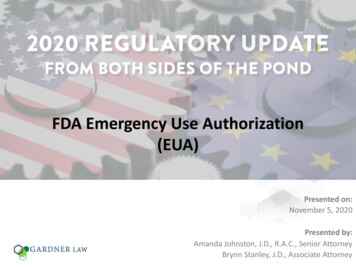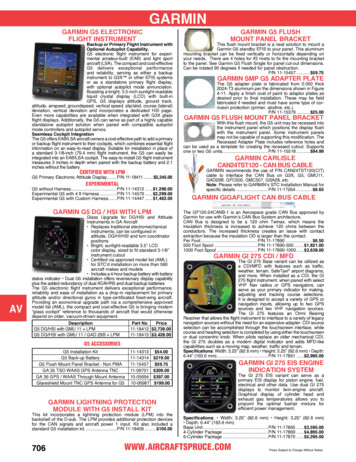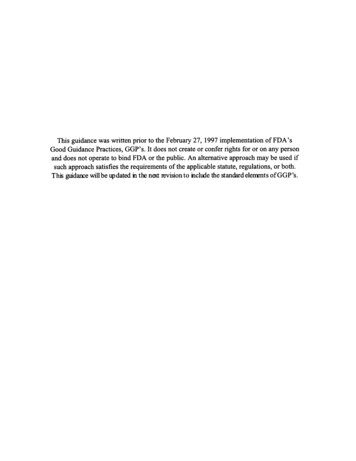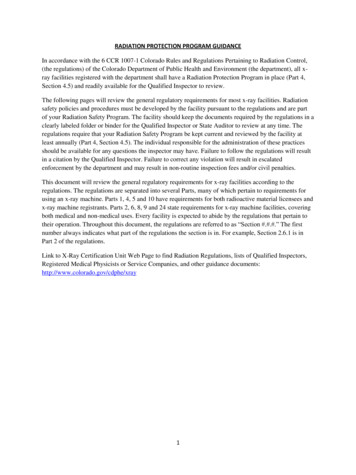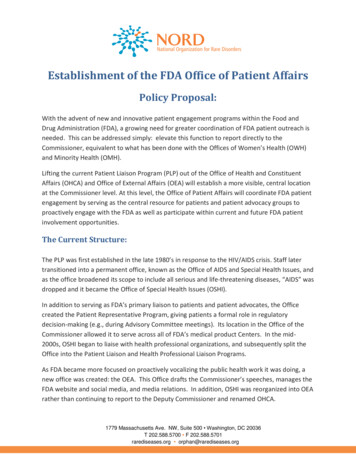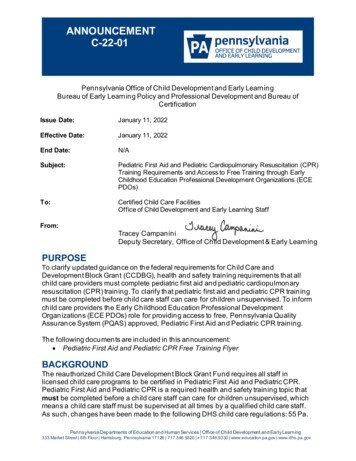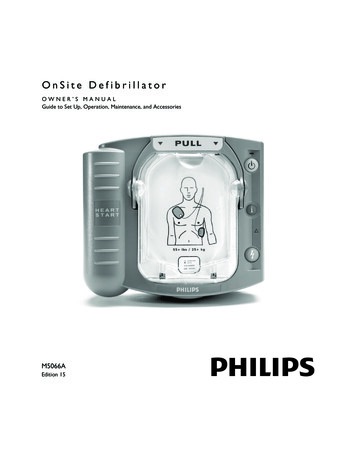
Transcription
HSI ONSITE English FDA.book Page 1 Monday, June 17, 2019 2:29 PMOnSite DefibrillatorOWNER’S MANUALGuide to Set Up, Operation, Maintenance, and AccessoriesM5066AEdition 15
HSI ONSITE English FDA.book Page 2 Monday, June 17, 2019 2:29 PMIntentionally blank.
HSI ONSITE English FDA.book Page 3 Monday, June 17, 2019 2:29 PMAtopPULLtopBfront viewback viewP H I L I P S M ED IC A L S YS T E M SThe OnSite Defibrillator M5066AAPads Cartridge Handle.Pull the handle to turn on theOnSite and remove the cartridge’shard cover.BReady Light. This green lighttells you the readiness of theOnSite.Blinking:Solid:Off:Cstandby mode(ready for use)in useneeds attention(OnSite “chirps” andi-button flashes)On/Off Button. Press thisgreen buttonto turn on theOnSite. To turn off the OnSite,press the green button again andhold it down for one (1) second.D Information Button. This“i-button”flashes blue when ithas information you can access bypressing it. It also flashes at thebeginning of a patient care pausewhen CPR guidance is enabled.ECaution Light. This triangularlightflashes during rhythmanalysis and is on when a shock isadvised, as a reminder that no oneshould be touching the patient.FShock Button. Wheninstructed by the OnSite to delivera shock, press this flashing orangebutton.G Infrared (IR)Communications Port. Thisspecial lens, or “eye,” is used totransfer OnSite data directly to orfrom a computer.H Speaker. When the device isbeing used, its voice instructionscome from this speaker.I Beeper. The OnSite “chirps”through this beeper to alert youwhen it needs attention.SMART Pads Cartridge. Thisdisposable cartridge contains selfadhesive pads with attached cable.Shown with adult OnSite padscartridge.JSMART Pads CartridgeLatch. Slide the latch to the rightKto release the pads cartridge forreplacement.LBattery. The non-rechargeable battery is inserted ina recess on the back of the OnSite.
HSI ONSITE English FDA.book Page 4 Monday, June 17, 2019 2:29 PMIntentionally blank.
HSI ONSITE English FDA.book Page 1 Monday, June 17, 2019 2:29 PMOnSite DefibrillatorP H I L I P S M ED I C A L S Y S T E M SQUICK REFERENCE
HSI ONSITE English FDA.book Page 2 Monday, June 17, 2019 2:29 PMIntentionally blank.
HSI ONSITE English FDA.book Page 3 Monday, June 17, 2019 2:29 PMHeartStart OnSiteM5066AAutomated External DefibrillatorOWNER’S MANUALEdition 15IMPORTANT NOTE:P H I L I P S M ED I C A L S Y S T E M SIt is important to understand that survival rates for sudden cardiac arrestare directly related to how soon victims receive treatment. For everyminute of delay, the chance of survival declines by 7% to 10%.Treatment cannot assure survival. In some victims, the underlying problemcausing the cardiac arrest is simply not survivable despite any available care.
HSI ONSITE English FDA.book Page 4 Monday, June 17, 2019 2:29 PMIntentionally blank.
HSI ONSITE English FDA.book Page 5 Monday, June 17, 2019 2:29 PMAbout this editionDevice trackingThe information in this guide applies to themodel M5066A HeartStart OnSite Defibrillator.Its technical contents apply to all modelsin the HeartStart HS1 family of defibrillators,including the HeartStart, the HeartStart OnSite,and the HeartStart Home defibrillator. Thisinformation is subject to change. Pleasecontact Philips at www.philips.com/AEDsupportor your local Philips representative forinformation on revisions.In the U.S.A., this device is subject to trackingrequirements by the manufacturer and distributors. Ifthe OnSite has been sold, donated, lost, stolen,exported, or destroyed, notify Philips Medical Systemsor your distributor.Edition HistoryP H I L I P S M ED I C A L S Y S T E M SEdition 15Publication Date: June 2019Publication #: 453564883331NoticesDevice manufacturerPhilips Medical Systems22100 Bothell Everett HighwayBothell, WA 98021-8431, USAPatentsPatents listing at www.ip.philips.com/patentmarking.For Technical SupportAll rights reserved.If you need technical support, please contact your localPhilips representative by calling the regional number onthe back cover of this manual, or go towww.philips.com/AEDsupport.Specifications are subject to change withoutnotice.To download additional copies of this manual, go towww.philips.com/AEDsupport. 2019 Koninklijke Philips N.V.Trademarks are the property of KoninklijkePhilips N.V. or their respective owners.CautionThe Philips OnSite Defibrillator is designed tobe used only with Philips-approved accessories.The OnSite may perform improperly if nonapproved accessories are used.
HSI ONSITE English FDA.book Page 6 Monday, June 17, 2019 2:29 PMIntentionally blank.
HSI ONSITE English FDA.book Page i Monday, June 17, 2019 2:29 PMCONTENTS1INTRODUCTION TO THE HEARTSTART ONSITEP H I LI P S M E D I C A L S YS T E M SDevice description . 1-1Sudden cardiac arrest . 1-1Essential performance . 1-2Indications for use . 1-2Contraindications . 1-2Dangers, warnings, and cautions . 1-2Probable adverse effects of the device on health . 1-7Clinical summary of safety & performance data . 1-8Principles of operation .1-16Implementation considerations .1-17For more information .1-172SETTING UP THE HEARTSTART ONSITEPackage contents . 2-1Setting up the OnSite . 2-1Recommended accessories . 2-43USING THE HEARTSTART ONSITEOverview .STEP 1: PULL the green handle .STEP 2: PLACE the pads .STEP 3: PRESS the Shock button .Treating infants and children .When emergency medical services arrive .Reminders .3-13-23-33-43-53-63-74 AFTER USING THE HEARTSTART ONSITEAfter each use . 4-1OnSite data storage . 4-35MAINTAINING THE HEARTSTART ONSITERoutine maintenance . 5-1i
HSI ONSITE English FDA.book Page ii Monday, June 17, 2019 2:29 PMPeriodic checks .Cleaning the OnSite .Disposing of the OnSite .Ready Light troubleshooting tips .Troubleshooting a chirping OnSite .5-15-25-25-25-3APPENDICESA Accessories for the HeartStart OnSiteB Glossary of termsC Glossary of symbols/controlsEConfigurationFTesting and troubleshootingG Additional technical information required for European conformityiiP H I L I P S M ED I C A L S YS T E M SD Technical information
HSI ONSITE English FDA.book Page 1 Monday, June 17, 2019 2:29 PM11INTRODUCTION TO THE HEARTSTART ONSITEDEVICE DESCRIPTIONThe HeartStart OnSite (M5066A) Defibrillator is a light-weight, easy-to-useAutomated External Defibrillator (AED), indicated to treat victims of suddencardiac arrest (SCA).P H I L IP S M E D I C A L S YS T E M SThe OnSite with the adult SMART pads cartridges (M5071A) is designated forover-the-counter sale; the infant/child SMART pads cartridge (M5072A) isprescription-use only. The HeartStart OnSite defibrillator is designed for use bya lay-person and is indicated for public access defibrillation.The OnSite prompts the user to take specific actions if a potentially shockablerhythm is detected. The OnSite uses defibrillation pads placed on the victim’sskin to deliver a shock. Once the defibrillation pads are placed on the patient, itanalyzes the heart rhythm, determines whether or not a shock is required,charges the capacitor, and indicates to deliver a shock. The OnSite is able toprovide verbal instructions to the user, detect where the user is in the eventresponse, and provide general CPR guidance.The HeartStart OnSite, which includes the necessary accessories of a batteryand SMART pads cartridge (adult and infant/child), uses a proprietary shockadvisory algorithm (Patient Analysis System [PAS]) and a truncated exponentialbiphasic shock waveform (impedance compensating SMART Biphasic waveform)to deliver a 150 J nominal shock to adults and 50 J nominal shock to pediatricpatients to achieve its intended use.SUDDEN CARDIAC ARRESTThe OnSite is used to treat ventricular fibrillation (VF), a common cause ofsudden cardiac arrest (SCA), and pulseless ventricular tachycardias (VTs). SCAis a condition that occurs when the heart unexpectedly stops pumping. SCA canoccur to anyone – infant, child, adult, male or female – anywhere, at any time.Many victims of SCA do not have warning signs or symptoms.1-1
HSI ONSITE English FDA.book Page 2 Monday, June 17, 2019 2:29 PMVF is a chaotic quivering of the heart muscle that prevents it from pumpingblood. The only effective treatment for VF is defibrillation. The OnSite treats VFby sending a shock across the heart, so it can start beating regularly again.Unless this is successful within the first few minutes after the heart stopsbeating, the victim is not likely to survive.Note: Rx Only. Federal law (USA) restricts the Infant/Child SMART PadsCartridge (M5072A) for sale by or on the order of a physician.ESSENTIAL PERFORMANCEThe Onsite defibrillator maintains safe and effective performance of thedefibrillation therapy and patient monitoring functions when operated in theelectromagnetic environment specified in the Appendix G tables.The HeartStart OnSite (Model M5066A) is indicated for use on potential victimsof cardiac arrest with the following symptoms: Unconsciousness; and Absence of normal breathingThe HeartStart OnSite (Model M5066A) is indicated for adults over 55 pounds(25 kg). The OnSite is also indicated for infants/children under 55 pounds (25kg) or 8 years old when used with the optional Infant/Child SMART Pads (ModelM5072A). If Infant/Child SMART pads are not available, or you are uncertain ofthe child’s age or weight, proceed with treatment using adult SMART Pads(Model M5071A).CONTRAINDICATIONSThe HeartStart OnSite Defibrillator should not be used when a patient isconscious or breathing normally.DANGERS, WARNINGS, AND CAUTIONSIt is important to understand how to use your HeartStart OnSite Defibrillatorsafely. Not following or considering this information could lead to a delay of1-2P H I L IP S M E D I C A L S YS T E M SINDICATIONS FOR USE
HSI ONSITE English FDA.book Page 3 Monday, June 17, 2019 2:29 PM1therapy for the patient or cause harm to yourself and others around you. Pleaseread these carefully. DANGER — Immediate hazards that will result in serious personal injuryor death to the user and/or the victim. WARNING — Conditions, hazards, or unsafe practices that can result inserious personal injury or death. CAUTION — Conditions, hazards, or unsafe practices that can result inminor personal injury, damage to the OnSite, or loss of data stored in thedevice.P H I L IP S M E D I C A L S YS T E M SNOTE: The HeartStart OnSite Defibrillator is designed to be used only withPhilips-approved accessories. The OnSite may perform improperly if nonapproved accessories are used.DANGERSflammable gasesbatteryIf the OnSite is used to give a shock in the presence of flammable gases such asin an oxygen tent, there is a risk of explosion. Move supplemental oxygen andoxygen delivery devices away from the defibrillation pads. (However, it is safe touse the OnSite on someone wearing an oxygen mask.)The HeartStart M5070A battery is not rechargeable. Do not try to recharge,open, crush, or burn the battery, or it may explode or catch fire.WARNINGSbatteryfluidsRemoving the battery may reset the OnSite, delaying patient defibrillation.Removing and reinserting the battery one or more times when the OnSite emitsa series of triple chirps may reset the device and cause it to report it is ready foruse, though it may be unable to deliver therapy during a rescue. Removing andreinserting the battery when your OnSite is emitting a pattern of triple chirpsshould only be done during an emergency. If your device is emitting a series oftriple chirps in stand-by mode, or after an emergency, please remove the OnSitefrom service and contact Philips immediately.Do not let fluids get into the OnSite. Avoid spilling any fluids on the OnSite orits accessories. Spilling fluids into the OnSite may damage it or cause a fire orshock hazard. Do not sterilize the OnSite or its accessories.1-3
HSI ONSITE English FDA.book Page 4 Monday, June 17, 2019 2:29 PMaccessoriespatient handlingcell phoneschildrenPerforming CPR or otherwise handling or moving the patient while the OnSite isanalyzing heart rhythm can cause an incorrect or delayed analysis. If the OnSitetells you a shock is advised while you are handling or moving the patient, stopthe vehicle or CPR and keep the patient as still as possible for at least 15seconds. This will give the OnSite time to reconfirm the analysis before tellingyou to press the Shock button.The OnSite can work correctly when it is fairly close to equipment likeemergency two-way radios and cell phones. Normally, using a cell phone nearthe patient should not cause a problem for the OnSite. However, it is best tokeep such equipment only as close as necessary to the patient and the OnSite.Do not allow the pads to contact other electrodes or metal parts that are incontact with the patient.Keep the OnSite out of reach of children to avoid the potential risk of inhalationor swallowing of small parts or strangulation by pads cables.Most cardiac arrests in children are not caused by heart problems. Whenresponding to cardiac arrest in an infant or child: Provide infant/child CPR while a bystander calls EMS and retrieves theOnSite. If no bystander is available, provide 1-2 minutes of CPR before callingEMS and retrieving the OnSite. If you witnessed the child's collapse, call EMS immediately and then getthe OnSite.Alternatively, follow your local protocol.CAUTIONSdevice handling1-4The OnSite was designed to be sturdy and reliable for many different useconditions. However, handling the OnSite too roughly can damage it or itsaccessories and will invalidate the warranty. Check the OnSite and accessoriesregularly for damage, according to directions.P H I L IP S M E D I C A L S YS T E M SpadsUsing damaged or expired equipment or accessories may cause the OnSite toperform improperly, and/or injure the patient or the user.
HSI ONSITE English FDA.book Page 5 Monday, June 17, 2019 2:29 PM1P H I L IP S M E D I C A L S YS T E M SmaintenanceImproper maintenance may damage the OnSite or cause it to functionimproperly. Maintain the OnSite according to directions. Check supplies,accessories, packaging, and spares for damage and expiration dating.skin burnsDo not let the pads touch each other or other electrodes, lead wires, dressings,medicine patches, etc. Such contact can cause electrical arcing and skin burnsduring a shock and may also divert the electrical current away from the patient’sheart. During a shock, air pockets between the skin and pads can cause skinburns. To help prevent air pockets, make sure pads stick well to the skin. Do notuse dried out pads because they will not provide good contact with the skin.shock hazardThe OnSite is not protected from electrical shock hazard if it is opened. TheOnSite is protected from electrical shock hazard while it is intact. Do not openthe OnSite, remove its covers, or attempt to repair it. There are no userserviceable components in the OnSite. If repair is required, return the OnSite toan authorized service center.patientIf the patient’s chest is not clean, the defibrillation pads may not make adequatecontact with the patient. Remove any medicine patches and residual adhesivefrom the patient’s chest before applying the pads.radiated emissionsenvironmental conditionsconfigurationWhile the OnSite complies with radiated emission standards, some medicalequipment may still be impacted by emissions from the OnSite. If this occurs,move the impacted equipment away from the OnSite until the OnSite is nolonger needed for the patient, or EMS arrives and takes over the scene.Environmental conditions may cause improper operation. Using the OnSiteoutside of the specified environmental range (temperature, humidity,atmospheric pressure) may result in incorrect or intermittent operation. Makesure the OnSite is stored in an environment according to the owner’s manual.An incorrectly configured language may prevent the OnSite from being appliedproperly. The OnSite uses lighted buttons and voice instructions to guide a userthrough a rescue. If a user is not familiar with the language that the OnSite is setto, the OnSite may not be used effectively to treat a patient in need, reducingthe likelihood of survival for that patient. Make sure that the language of theOnSite is set to a language that the majority of the users of that OnSite may befamiliar with.1-5
HSI ONSITE English FDA.book Page 6 Monday, June 17, 2019 2:29 PMpacemakersDo not place the pads directly over an implanted pacemaker or defibrillator. Anoticeable lump with a surgical scar should indicate the position of an implanteddevice.padsIf the pads do not stick well to the skin, check that the pads adhesive has notdried out. Each pad has a layer of adhesive gel. If the gel is not sticky to thetouch, replace the pads with a new set. (For ease of handling, the pad is designedwith a non-gel area around the connector cable.)device operationThe OnSite will only deliver a shock if the flashing orange Shock button ispressed when the instruction is given. If the Shock button is not pressed within30 seconds after the instruction, the OnSite will disarm itself, and (for the firstCPR interval) give a reminder to make sure emergency medical services havebeen called. The OnSite will then begin a CPR interval. This is designed tominimize interruption of CPR and help ensure ongoing patient support.accessoriesDo not leave the OnSite without a set of pads connected; the device will startchirping and the i-button will start flashing.The OnSite runs daily self-tests. As long as the green Ready light is blinking, it isNOT necessary to test the defibrillator by initiating a battery insertion self-test.This uses battery power and risks draining the battery prematurely.cprpatient handling1-6CPR causes injury to the patient. Even when CPR is applied correctly, thepatient’s chest may become bruised or ribs may be fractured. Performing CPRincorrectly could cause additional injuries to a patient, or may not provideneeded benefit to the patient. Be sure to follow the CPR guidance instructionsprovided by the OnSite. Be sure to turn on CPR guidance if you are unsure ofyour CPR skills.Keep the patient still and keep any movement around the patient to a minimumduring rhythm analysis. Do not touch the patient or the pads while the Cautionlight is on solid or flashing. If the OnSite is unable to analyze due to electrical“noise” (artifact), it will tell you to stop all movement and remind you not totouch the patient. If the artifact continues for more than 30 seconds, the OnSiteP H I L IP S M E D I C A L S YS T E M SIf for any reason you want to turn off the defibrillator during a use, you can pressthe On/Off button – holding it down for at least one second - to return thedevice to standby mode.
HSI ONSITE English FDA.book Page 7 Monday, June 17, 2019 2:29 PM1will pause briefly to allow you to deal with the source of the noise, then resumeanalysis.PROBABLE ADVERSE EFFECTS OF THE DEVICE ON HEALTHP H I L IP S M E D I C A L S YS T E M SFollowing are the probable adverse effects of the device on health. Failure to identify shockable arrhythmia Failure to deliver a defibrillation shock in the presence of ventricularfibrillation (VF) or pulseless ventricular tachycardia (VT), which mayresult in death or permanent injury Inappropriate energy, which could cause failed defibrillation orpostshock dysfunction Myocardial damage Fire hazard in the presence of high oxygen concentration or flammableanesthetic agents Incorrectly shocking a pulse sustaining rhythm and inducing VF orcardiac arrest Bystander shock from patient contact during defibrillation shock; Interaction with pacemakers Skin burns around the defibrillation pads placement area Allergic dermatitis due to sensitivity to the materials used in thedefibrillation pads construction Minor skin rash.CLINICAL SUMMARY OF SAFETY & PERFORMANCE DATAPhilips, or its predecessor Heartstream, was directly responsible for theconduct of clinical trials related to the safety and effectiveness of thePhilips family of AEDs.A. Adult Defibrillation WaveformThe pivotal clinical trial supporting the Philips SMART biphasic waveform wascomprised of 3 studies. The first was a single center feasibility trial (Gemini I);1-7
HSI ONSITE English FDA.book Page 8 Monday, June 17, 2019 2:29 PMfollowed by a prospective randomized clinical trial (Gemini II), and finally a safetysub-study (Gemini Safety). These studies supported the safety and effectivenessof the SMART Biphasic defibrillation waveform.1. Gemini I Feasibility Study1Objective: Gemini I was a clinical evaluation of the transthoracicdefibrillation effectiveness of two different biphasic truncatedexponential waveforms (115 J and 130 J), with that of a then standard200 J monophasic damped sine waveform.Results: Thirty-three patients were enrolled and 30 completed theprotocol. Of the 30 patients, 22 were men. All were undergoing aplanned procedure for ICD implantation and consented to inclusion inthe clinical study. All 3 waveforms were equally effective at 97%, with 1patient failing to be defibrillated with each waveform. The defibrillationenergy for the two biphasic waveforms was significantly lower ascompared to the damped sine wave (p 0.001), as was the peakcurrent and voltage.Conclusion: The results showed that biphasic truncated transthoracicshocks of low energy (115 J and 130 J) were as effective in the testedgroup as 200 J damped sine wave shocks used in standard transthoracicdefibrillators.1 BardyGH, Gliner BE, Kudenchuk PJ, Poole JE, Dolack GL, Jones GK, Anderson J,Troutman C, Johnson G: Truncated biphasic pulses for transthoracic defibrillation.Circulation 1995, 91(6):1768-17741-8P H I L IP S M E D I C A L S YS T E M SStudy Design: The study was a single site, prospective, randomized andblinded study involving patients undergoing transvenous ICD surgery.Transthoracic ventricular defibrillation rescue shocks were tested aftera failed transvenous defibrillation shock was delivered in the course ofICD testing. Each of the three different rescue shocks was tested inrandom order in each patient. The shock was considered a success if itdefibrillated a patient. The biphasic waveforms were generated using acustom, experimental defibrillation (Heartstream) system. The dampedsine wave was from the Physio-Control LifePak 6s defibrillator.
HSI ONSITE English FDA.book Page 9 Monday, June 17, 2019 2:29 PM12. Gemini II Pivotal Study2Objective: The objective of this randomized, controlled, multi-centertrial was to evaluate the safety and effectiveness of the investigationalbiphasic truncated exponential waveform vs. the control monophasicdamped sinusoidal waveform from standard commercially marketedexternal defibrillators.Study Design: The study was a prospective, randomized, doubleblinded investigation conducted at 14 sites in the United States andCanada. The study population consisted of 318 patients undergoingtesting for insertion of an implantable defibrillator or follow-upelectrophysiological evaluation post-implantation. In this study rescueshocks of investigational biphasic waveforms of 115 and 130 J werecompared to monophasic waveforms of 200 J and 360 J.P H I L IP S M E D I C A L S YS T E M SResults: A total of 318 patients were enrolled in the study, and afterexclusion criteria were applied there were 294 patients included in thestudy analyses, for a total of 513 shocks delivered during the study.2 BardyGH, Marchlinski FE, Sharma AD, Worley SJ, Luceri RM,Yee R, Halperin BD,Fellows CL, Ahern TS, Chilson DA et al: Multicenter comparison of truncatedbiphasic shocks and standard damped sine wave monophasic shocks fortransthoracic ventricular defibrillation. Transthoracic Investigators. Circulation 1996,94(10):2507-25141-9
HSI ONSITE English FDA.book Page 10 Monday, June 17, 2019 2:29 PMOverall, for the 294 included patients analyzed, 513 transthoracicdefibrillation attempts (shocks) were performed. The overallbreakdown by waveform and success rates is as follows in the tablebelow.Successful Defibrillations by Waveform TypeWaveformSuccessfulDefibrillation N (%)95% ConfidenceInterval (%)115 J Biphasic86 (89)82-95130 J Biphasic144 (86)81-92200 J Damped Sine143 (86)81-91360 J Damped Sine80 (96)92-100The energy dose increased to 150 J in later clinical studies (ORCAstudy by Schneider3), and 150 J is the energy dose in the SMARTbiphasic waveform used in the OnSite AED.3 Schneider T, Martens PR, Paschen H, Kuisma M, Wolcke B, Gliner BE, Russell JK,Weaver WD, Bossaert L, Chamberlain D: Multicenter, randomized, controlled trialof 150-J biphasic shocks compared with 200- to 360-J monophasic shocks in theresuscitation of out-of-hospital cardiac arrest victims. Optimized Response toCardiac Arrest (ORCA) Investigators. Circulation 2000, 102(15):1780-17871-10P H I L IP S M E D I C A L S YS T E M SConclusion: For the primary hypothesis, the effectiveness of the 130 Jtruncated biphasic waveform and the 200 J monophasic waveform wasnot significantly different using the Pearson chi-square test (p 0.97).The 115 J and 130 J biphasic waveforms both demonstratetransthoracic defibrillation effectiveness equivalent to either the 200 Jor 360 J monophasic waveforms.
HSI ONSITE English FDA.book Page 11 Monday, June 17, 2019 2:29 PM13. Gemini II Safety Sub-Study4A single center, prospective analysis was conducted to look at potentialdifferences in ECG ST-segment changes when comparing thewaveforms from the pivotal trial. In this study the ST-segment changeswere used as a surrogate for myocardial injury. Each patient receivedtwo low-energy biphasic waveform shocks at 115 J and 130 J and a 200J monophasic shock. ECGs were reviewed by two blinded, independentreviewers. This 30 patient sub-study showed that ST-segment elevationwas significantly greater for the 200 J damped sine wave (p 0.001),indicating a potential safety advantage associated with the biphasicwaveform.4. ORCA (Out of Hospital Response to Cardiac Arrest) Trial5P H I L IP S M E D I C A L S YS T E M SThis postmarket study supports the safe and effective use of the PhilipsHeartStart HS1 (Home and OnSite) in out-of-hospital defibrillation.The ForeRunner device used in this study, and the HeartStart HS1(Home and OnSite) device subject to PMA, both use SMART biphasicwaveforms and PAS shock advisory algorithm technology.Study Design: Patients were prospectively enrolled in four EuropeanEMS systems and included a total of 338 patients. First responders usedeither impedance-compensated biphasic waveform AEDs (PhilipsForeRunner 150 J) or standard monophasic damped sine (MDS) andmonophasic truncated exponential (MTE) AEDs with an escalatingenergy protocol on victims of sudden collapse when defibrillatorapplication was indicated. A sequence of up to three defibrillationshocks was delivered (150 J for each of the three biphasic shock; formonophasic AEDs, 200 J, 200 J, then 360 J).4Reddy RK, Gleva MJ, Gliner BE, Dolack GL, Kudenchuk PJ, Poole JE, Bardy GH:Biphasic transthoracic defibrillation causes fewer ECG ST-segment changes aftershock. Annals of emergency medicine 1997, 30(2):127-1345Schneider T, Martens PR, Paschen H, Kuisma M, Wolcke B, Gliner BE, Russell JK,Weaver WD, Bossaert L, Chamberlain D: Multicenter, randomized, controlled trialof 150-J biphasic shocks compared with 200- to 360-J monophasic shocks in theresuscitation of out-of-hospital cardiac arrest victims. Optimized Response toCardiac Arrest (ORCA) Investigators. Circulation 2000, 102(15):1780-17871-11
HSI ONSITE English FDA.book Page 12 Monday, June 17, 2019 2:29 PMResults: A total of 338 patients were enrolled. After exclusion criteriawere applied, 115 patients were included in the principal analyses, 54treated with biphasic a
PHILIPS MEDICAL SYSTEMS HeartStart OnSite M5066A Automated External Defibrillator Edition 15 IMPORTANT NOTE: It is important to understand that survival rates for sudden cardiac arrest are directly related to how soon victims receive treatment. For every minute of delay, the chance of survival
